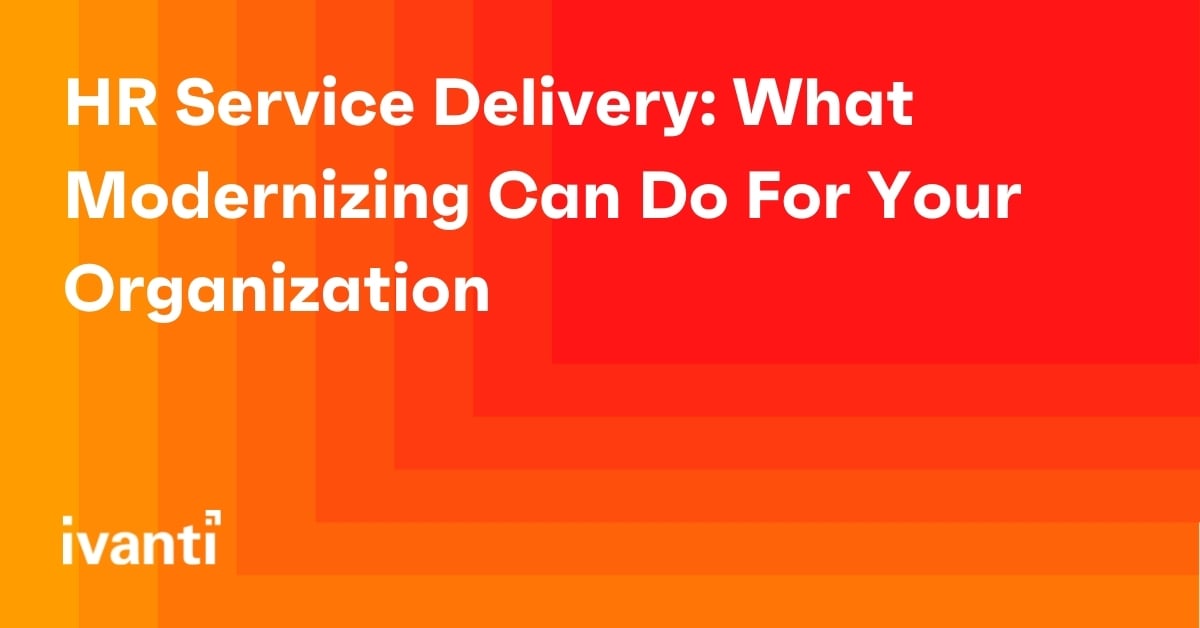HR Service Delivery: What Modernizing Can Do For Your Organization
When it comes to running a Human Resources (HR) department successfully, it’s a balancing act of maximizing budget and productivity. HR is a core part of the enterprise, but it is often up against flat or shrinking budgets. A lot of time gets invested into searching for ways to eliminate full-time employee hours spent on tedious manual tasks and re-shift its staff’s focus to driving more strategic initiatives. But due to its broad range of responsibilities, HR practitioners often struggle to provide a single, seamless solution for employee engagement. This typically leads to one or both of these negative consequences:
- HR managers are overburdened with an avalanche of employee requests.
- Employees are unhappy with their HR experience and frustrated with slow response times.
It doesn’t have to be this way, though. Modernizing HR service management (HRSM) can help you avoid both of these pitfalls, and with a huge plus to boot: A streamlined approach not only allows HR staff to focus on more strategic tasks — it improves the employee experience and reaps benefits across the entire organization.
Here are some of the advantages of transforming your HRSM.
The Employee Experience Is Drastically Improved
In today’s digital workplace, employees have similar expectations to consumers, which means they expect HR to deliver services on demand and in real time. Many of today’s business leaders have recognized this and are making shifts in their digital efforts to focus on optimizing the employee experience. Deloitte highlights this emerging trend.
“Organizations are no longer assessed based only on traditional metrics such as financial performance, or even the quality of their products or services. Rather, organizations today are increasingly judged on the basis of their relationships with their workers, their customers, and their communities, as well as their impact on society at large—transforming them from business enterprises into social enterprises.”
Business leaders recognize that modernizing their HRSM is a great place to start. And HR practitioners understand that employees should be able to self-serve, especially when it comes to topics like payroll and time off. Employees want to be able to search and find these answers for themselves, in one place, and at any time. Here's the good news: a modernized HRSM solution with an employee self-service portal can make this possible.
Today’s HRSM tools can dramatically improve the employee experience in many ways, including helping employees feel taken care of when they can get ~75-80 percent of their HR needs through an HR self-service portal. Modern solutions provide a unified interface for accessing important HR-related information and resources.
Employees Get the Customized, Personalized HR Interaction They Expect
New HRSM solutions can deliver a much more personalized employee experience. Via the HR knowledge base, you can provide customized content based on employee attributes—that way, they only see the targeted information relevant to their specific role, status, position and geography.
In many ways, these new HRSM tools behave a lot like consumer websites—they capture data to understand online buying behavior, adding personalization and customized display results based on consumer preferences.
HR Wins Big with New HRSM Tools, Too
Above all else, the most important focus on HRSM is to optimize the employee experience to improve employee satisfaction, efficiency, and productivity.
HR can benefit from HRSM solutions in many ways, including:
- Increased HR productivity: Self-service, a foundational aspect to a well-equipped HRSM solution, can help drastically reduce the volume of repetitive employee requests by 75 percent . This frees you up to focus on resolving the remaining 25 percent of requests, as well as work on more strategic projects.
- More efficiency: Modern HRSM solutions enable you to streamline and automate even the most complex cross-departmental workflows. You can eliminate manual processes like phone and email communication by automatically routing service requests to the appropriate fulfillers like security, facilities and IT. This removes bottlenecks and improves service delivery and efficiency.
- Better analytics and reporting: Today’s HRSM tools are also pre-built with on-demand analytics that provide meaningful operational data and help drive accountability. Measure and monitor KPI’s such as time-to-resolution—which is essential for understanding the impact and success of your HRSM solution. Drastically reduce the time to fulfill requests, even as the number of requests steadily increase in volume. And access individual records so you can drill-down to details whenever you need.
Thinking about modernizing your HR service delivery strategy? Stay tuned for more details on Ivanti Neurons for HR, launching next month. Your organization will be able to streamline and automate your HR service delivery, from onboarding to case management. Company-wide efficiency can grow exponentially, and your self-service portal delivers the modern HR experience that employees expect.

